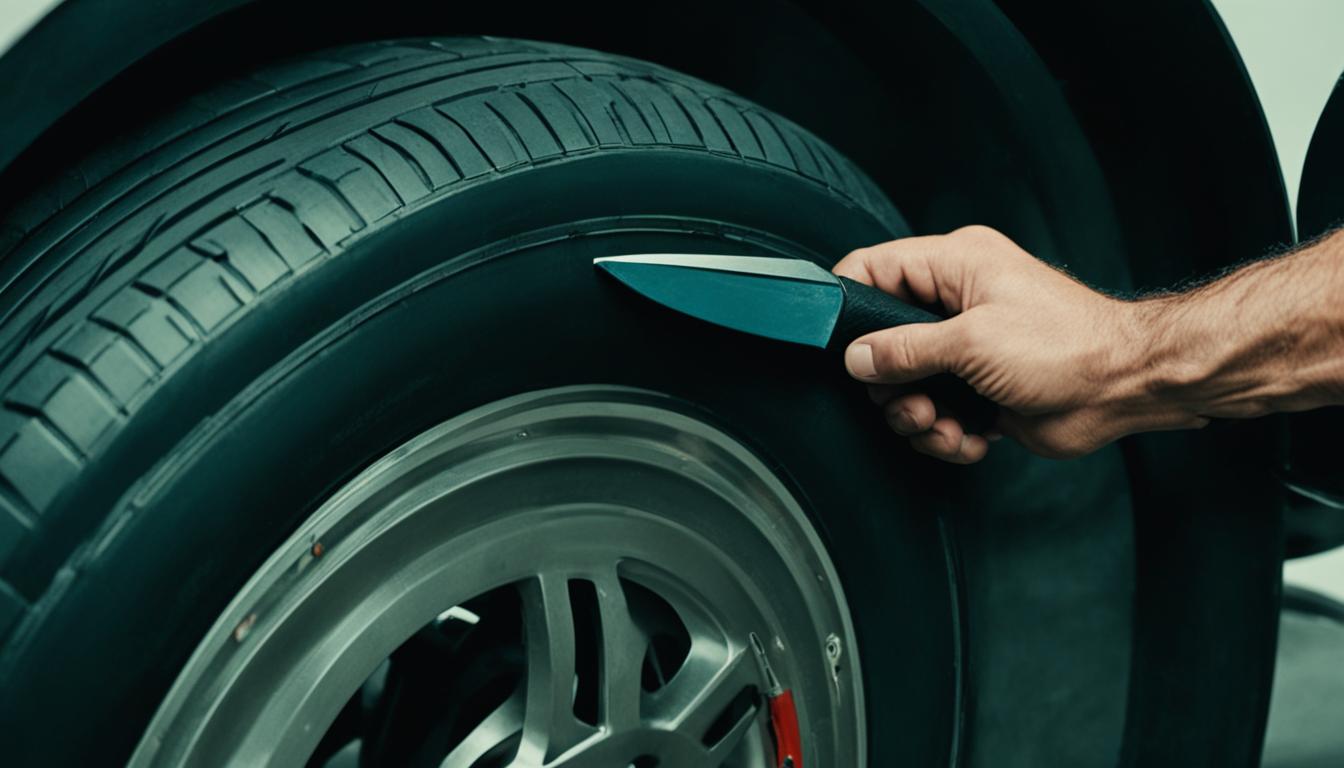Experienced cyclists know that punctures are a common occurrence, so it’s important to learn how to change a bike tire. Whether you’re a casual cyclist or a more serious rider, being able to change a bike tire is a valuable skill. If the tire is damaged beyond repair or severely worn, it may need to be replaced. Most cyclists are able to handle minor punctures themselves, but for more severe damage, it’s best to replace the tire. Before starting the process of changing a bike tire, make sure to choose a comfortable position for your bike, whether that’s laying it on its side or investing in an upright bike stand. If you’re changing the back tire, be sure to adjust the gears to the smallest ring to make the removal process easier.
Read More : Adjust Bike Brakes Easily: Step-by-Step Guide
Key Takeaways:
- Learning how to change a bike tire is important for both casual and serious cyclists.
- Replacing a severely damaged tire is recommended, while minor punctures can typically be fixed.
- Choosing a comfortable position for your bike and adjusting gears can make the tire changing process easier.
- For back tire removal, adjust the gears to the smallest ring.
Step-by-Step Guide: How to Remove the Old Tire
To remove the old tire, follow these steps:
- Start by removing the quick-release lever or wheel nut. If your bike has a quick-release lever, simply loosen and remove it by pulling up and turning it 180 degrees. Set it aside for reinstallation later. If your bike doesn’t have a quick-release lever, use a 15 millimeter wrench to loosen and remove the wheel nut.
- Once the lever or nut is removed, disconnect the brake cables if necessary.
- Lift the wheel off the frame and deflate the tire completely.
- Use tire levers to unhook the tire from the wheel, working your way around the rim until the tire is free.
- Inspect the tire for any serious damage and determine if both the inner tube and the outer tire need to be replaced.
Removing the old tire is an important step in the process of changing a bike tire. It allows you to assess the condition of the tire and determine if it can be repaired or needs to be replaced entirely. By following these steps carefully, you can safely remove the old tire and move on to installing a new one.
Installing the New Tire and Tube
To complete the process of changing a bike tire, follow these steps to install the new tire and tube:
- Add air to the new tube: Start by adding air to the new tube. This will help it hold its shape and make installation easier. Unfold the tube and check for any pre-existing damage to ensure it’s in good condition.
- Connect the tube to a bike pump or tire inflator: Attach the tube to a bike pump or tire inflator and add air. Be cautious not to overinflate the tube; filling it partially is sufficient for now.
- Inspect the tire for damage: Before installing the new tire, thoroughly examine both the inside and outside walls for any existing damage, signs of wear and tear, or sharp objects that could cause future issues.
- Refit one side of the tire on the rim: Place one side of the tire onto the rim, making sure that the tread is facing the correct direction.
- Insert the inner tube: Slide the air valve of the inner tube through the valve hole. Then, carefully feed the rest of the inner tube into the hollow space within the tire and wheel rim.
- Twist the outer edge of the tire into place: Twist the outer edge of the tire so that it slips smoothly into the wheel rim. If required, you can use a tire lever to assist in positioning the last section of the tire where it is the tightest.
- Fully inflate the inner tube: Pump air into the inner tube until it is fully inflated.
- Reinstall the wheel onto the bike: Now, it’s time to reinstall the wheel onto the bike. Make sure to reattach the brake cables if you had to disconnect them. Additionally, if you removed the back tire, lift the chain back onto the gears.
With the new tire and tube successfully installed, your bike is ready to hit the road once again!
Tire Installation Tips
Follow these additional tips to ensure a smooth and successful tire installation process:
- Before inserting the tube, carefully inspect the inside of the tire for any punctures or damage.
- Ensure that the tire’s tread is aligned correctly before fitting it onto the rim.
- For stubborn or tight tire sections, you can use a tire lever to help position them properly.
- Be cautious not to use excessive force or tools that could potentially damage the rim or tube.
- After installing the tire, fully inflate the inner tube to the recommended pressure level.
Recommended Bike Tire and Tube Brands
| Brand | Description | Price Range |
|---|---|---|
| Continental | Offers a wide range of high-quality tires and tubes for various types of bikes. | $20 – $80 |
| Schwalbe | Known for their puncture-resistant tires and durable tubes, ideal for long-distance riders. | $25 – $100 |
| Michelin | Produces reliable and high-performance tires suitable for both road and off-road cycling. | $30 – $90 |
| Maxxis | Offers a wide selection of tires designed for various terrains and biking disciplines. | $25 – $120 |
Tips and Tricks for Changing Bike Tires
Changing bike tires can sometimes be challenging, especially when dealing with tight tires or rims. Here are some tips and tricks to make the process easier:
- Deflate the tube completely: Before removing the old tire, make sure to deflate the tube completely. This will make it easier to remove the tire from the rim.
- Check for damage: When installing the new tire and tube, check for punctures and damage on the inside of the tire before inserting the tube. This will help prevent further issues down the road.
- Proper inflation: Use the correct amount of air pressure when inflating the tube to prevent over or under inflation. Check the recommended PSI (pounds per square inch) for your specific tire and adjust accordingly.
- Align the tread: Pay attention to the direction of the tire’s tread and make sure it is aligned correctly. This will ensure optimal traction and performance.
- Double-check the bead: If you’re struggling to install the last part of the tire, double-check that both beads of the tire are in the rim’s central channel. This will make it easier to seat the tire properly.
- Avoid excessive force: Avoid using excessive force or tools that could damage the rim or tube. Use tire levers only when necessary and handle with care.
- Have the right tools: Always make sure you have the necessary tools and equipment on hand for changing a bike tire, including tire levers, a bike pump or tire inflator, and any specific tools required for your bike model.
By following these simple bike tire changing tips, you can save time and prevent unnecessary frustration during the process. With practice and patience, you’ll become a pro at changing bike tires in no time.

Maintaining Your Bike Tires
Proper maintenance is essential for keeping your bike tires in optimal condition. Here are a few bike tire maintenance tips to help prolong their lifespan:
- Regularly inspect your tires for signs of wear and tear, such as cracks, bulges, or worn-out tread. Replace any damaged tires promptly to prevent potential accidents.
- Keep your tires properly inflated to the recommended PSI. Underinflated tires can increase rolling resistance, while overinflated tires can increase the risk of punctures.
- Clean your tires and rims regularly to remove any debris or dirt that could cause damage or affect the tire’s grip.
- Store your bike in a cool, dry place to prevent unnecessary exposure to extreme temperatures or moisture, which can deteriorate the rubber compound of the tires.
- Consider using tire liners or sealant to reduce the risk of punctures. These products create an additional layer of protection between the tire and the road.
- Inspect your tire tubes regularly for any signs of damage or leaks. Replace any damaged tubes promptly to avoid unexpected flats on your rides.
By following these tips for changing bike tires and practicing proper maintenance, you can enjoy smoother rides and improve the overall performance of your bike.
Conclusion
Learning how to change a bike tire is an essential skill for any cyclist. By following the step-by-step guide and using the tips and tricks provided, you can quickly and easily change a bike tire when needed.
Regular maintenance and proper storage of your bike can help prevent tire damage and prolong the lifespan of your tires. Remember to always replace or repair any tire damage as soon as possible to avoid further issues.
By taking the time to learn how to change a bike tire, you’ll be able to get back on the road quickly and confidently. So don’t let a flat tire derail your cycling adventures—equip yourself with the knowledge and skills to handle any tire change situation with ease.
FAQ
Why is it important to learn how to change a bike tire?
Being able to change a bike tire is a valuable skill for both casual and serious cyclists. Punctures are a common occurrence, and knowing how to change a tire can save you time and money.
What should I do before starting the process of changing a bike tire?
Before changing a bike tire, choose a comfortable position for your bike, such as laying it on its side or using an upright bike stand. If you’re changing the back tire, adjust the gears to the smallest ring for easier removal.
How do I remove the old tire?
Start by removing the quick-release lever or wheel nut. If your bike has a quick-release lever, pull it up and turn it 180 degrees to remove it. If your bike doesn’t have a quick-release lever, use a 15 millimeter wrench to remove the wheel nut. Disconnect the brake cables if necessary, lift the wheel off the frame, and deflate the tire completely. Use tire levers to unhook the tire from the wheel, working your way around the rim until the tire is free.
How do I install the new tire and tube?
Start by adding air to the new tube to help it hold its shape. Unfold the tube and check for any pre-existing damage. Connect the tube to a bike pump or tire inflator and add air. Inspect the inside and outside walls of the tire for damage or sharp objects. Fit one side of the tire on the rim, ensuring the tread is pointed in the correct direction. Slide the air valve through the valve hole and feed the inner tube into the tire and wheel rim. Twist the outer edge of the tire to slip it into the rim. If needed, use a tire lever to help position the last part of the tire. Fully inflate the tube and reinstall the wheel onto the bike, reattaching the brake cables and lifting the chain back onto the gears if necessary.
What are some tips and tricks for changing bike tires?
Before removing the old tire, deflate the tube completely. When installing the new tire and tube, check for punctures or damage inside the tire. Use the correct amount of air pressure when inflating the tube. Pay attention to the direction of the tire’s tread. If struggling with the last part of the tire, double-check that both beads are in the rim’s central channel. Avoid using excessive force or tools that could damage the rim or tube. Always have the necessary tools and equipment on hand.


